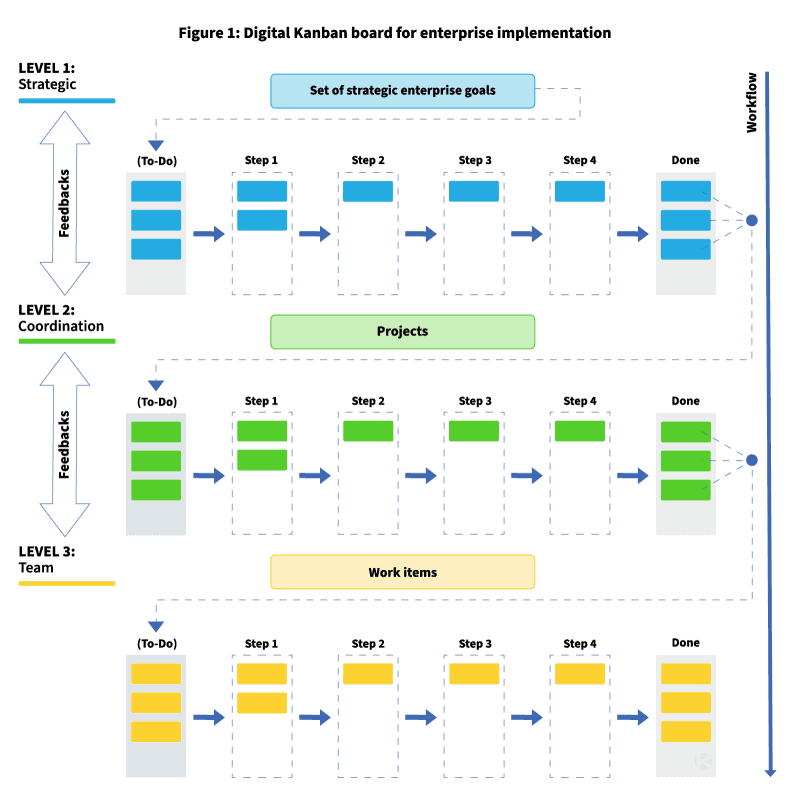
In the context of a highly dynamic and competitive work environment, companies and businesses are required to deliver services or products quickly and effectively in order to survive in their fields of work.
To get work done correctly throughout daily activities, teams often need to apply diverse work methodologies, depending on the nature of the core business and strategic goals.
One valuable work methodology available today that can help businesses better tackle potential challenges is the Kanban method.
Being originally designed as a Lean Manufacturing tool, the Kanban method allows visual control and understanding of the process flow employed to deliver high quality products or services.
Now you might be wondering how to jumpstart the Kanban implementation in your enterprise? That’s exactly the focus of this article.
How to Initiate Your Enterprise Kanban Implementation
In order to implement Kanban in an enterprise, some important actions must be carefully considered aiming at getting it done appropriately.
1. Target Training
Firstly, it is important to comprehend the fundamental theory concerning the Kanban method through target training. During the implementation process, it is vital to take into account all possible user levels, as for example, strategic, coordination and team level. Even if at a first glance an enterprise Kanban implementation seems easy to understand and clear enough after design and application, the end users need to comprehend the fundamental theory. During training other additional aspects related to the Kanban implementation should be considered, for instance, the required investments and a suitable strategy to implement the Kanban system.
2. Start with Current Process
Before implementing a Kanban system, it is recommended to analyze both processes and operations that are currently being performed in the company. This aims at assessing process improvement opportunities that are possible to be conducted in the existing process.
3. Pilot Kanban System
A conceivable starting point for implementing Kanban on a large scale across an enterprise consists in running a pilot Kanban system on a single workflow of an existing product or service. For that, firstly an appropriate product or service workflow must be defined. Next, it is important to analyze whether the workflow concerning the product or service is suitable for implementing a Kanban system.
One prior characteristic for an initial pilot Kanban system is that it should be implemented on the enterprise’s headquarter in order to receive high significance and visibility.
Secondly, whenever possible, the pilot Kanban system should be implemented for a product or service workflow which is linked to or shared with already existing workflows in the company. This allows other existing workflows to perceive the results associated with the implementation of the pilot Kanban system.
Potential areas of interest for implementing the pilot Kanban system are those in which the high administration or management are eager to reduce costs, risks or aims at process improvement. A pilot project in these areas is more likely to receive the required attention and support, thus contributing for a successful implementation of the Kanban system.
As soon as the pilot Kanban system reaches its goals and delivers good results it is then possible to scale it out across the whole enterprise.
The Use of Digital Kanban Boards
Digital Kanban boards turn out to be very helpful tools to jumpstart Kanban implementation across the whole enterprise. This is possible by using digital Kanban boards across different levels of the enterprise, Figure 1.

The digital Kanban board shown in Figure 1 schematically depicts three existing levels in an enterprise. Other levels could be added to the board in case they are significant to be considered. The higher level represents the strategic activities being executed in the enterprise, whereas the middle level shows the coordination level and the lowest level characterizes the work items that are done in the team level.
Each of the three levels (i.e. Level 1: Strategic, Level 2: Coordination and Level 3: Team) can be understood as individual processes being composed of particular consecutive steps represented by the vertical dashed columns.
It is possible to observe that there is a relationship among the enterprise’s levels and that the workflow is oriented top-down, that is, from the strategic level up to the team level. In this case, the high-level strategic activities can be divided into specific projects implemented in the coordination level which are in turn divided again into work items that need to be completed at the team level.
Going Digital with Your Enterprise Kanban Implementation
The use of digital Kanban boards as the one shown in Figure 1 can help solve the existing gaps between planning, (which is normally carried out through high-level strategic activities), and execution of work items at the team level.
Enterprise Kanban is becoming a valuable tool for today’s competitive and agile demands. Through Enterprise Kanban implementation, work teams can easily visualize workflow and processes throughout the company. Additionally, it is also possible to optimize workflow, communicate the progress of work being developed and discover occasional bottlenecks which could hinder the process. This can drive continuous improvement initiatives and promotes collaboration in the whole enterprise.
Learn to Work Smarter, Not Harder!
Get our top articles weekly.
Table Of Contents
Discover many more posts…







